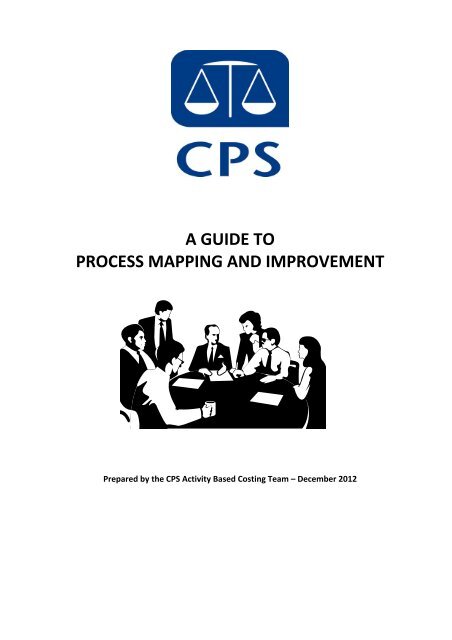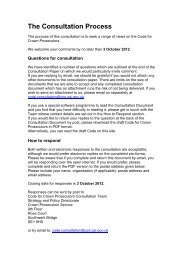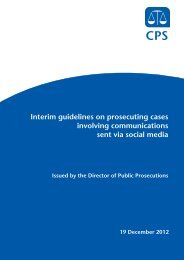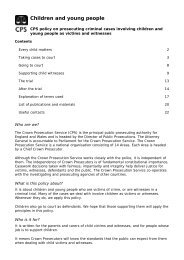A guide to Process Mapping - Crown Prosecution Service
A guide to Process Mapping - Crown Prosecution Service
A guide to Process Mapping - Crown Prosecution Service
You also want an ePaper? Increase the reach of your titles
YUMPU automatically turns print PDFs into web optimized ePapers that Google loves.
A GUIDE TOPROCESS MAPPING AND IMPROVEMENTPrepared by the CPS Activity Based Costing Team – December 2012
CONTENTS1. Introduction Page 32. What is process mapping? Page 43. Why process map? Page 44. Construction of <strong>Process</strong> maps Page 5Types of <strong>Process</strong> Map Page 5Basic Flowcharting symbols Page 6Preparation for <strong>Process</strong> mapping Page 6Gathering information Page 8Constructing a <strong>Process</strong> Flowchart Page 9Constructing a Deployment Flowchart Page 105. <strong>Process</strong> Improvement Page 11Critical examination Page 11What is wasted work? Page 136. What are the characteristics of an efficient and effective process? Page 137. Further information Page 152
1. Introduction1.1 CPS Areas are regularly required <strong>to</strong> examine their processes when workingpractices change. A key element of all process examination, or improvement, isthe requirement <strong>to</strong> define the sequence of activities presently undertaken. Thisis a necessary step prior <strong>to</strong> any development of new working procedures.1.2 This Guide aims <strong>to</strong> provide basic guidance and principles of process mapping,<strong>to</strong>gether with details of the key features of any process improvement exercise.1.3 The Guide is based both on lessons learned from process mapping exerciseswhere ABC staff have provided technical support, and an established formalWork Study technique known as “Method Study” where processes are:SelectedRecordedExaminedDevelopedInstalled (Implemented)MaintainedThis Guide concentrates on the Selection phase of existing processes through<strong>to</strong> Development of new processes.1.4 <strong>Process</strong> mapping enables us <strong>to</strong> clearly and simply record existing processes,examine them thoroughly and develop improvements by:Eliminating unnecessary tasksClarifying roles within the processReducing delays and duplicationReducing the number of staff required1.5 It can also assist in the creation and implementation of an effective process,often in partnership with the Police or any other agency, by:Identifying areas of duplication;Agreeing common processes;Improving the Police/CPS interface;Achieving maximum effectiveness in CPS/Police operations.3
conditions that make it difficult for staff <strong>to</strong> work effectively, and often createfurther problems.3.2 If you do not measure a process, you will not be able <strong>to</strong> manage it effectivelyand if you cannot manage a process, you cannot improve it.3.3 It has been estimated that people working in organisations can waste about 15– 20% of their time by re‐doing things that are wrong, chasing things withoutresult, querying incomplete instructions, doing other people’s jobs and so on.3.4 <strong>Process</strong> mapping enables us <strong>to</strong> clearly define the current processes in chartform, identifying problem areas such as bottlenecks, capacity issues, delays orwaste. Once identified, this knowledge provides a solid basis from which <strong>to</strong>develop solutions and introduce and plan new improved processes.3.5 <strong>Process</strong> mapping enables an organisation <strong>to</strong>: Establish what is currently happening, how predictably and why; Measure how efficiently the process is working; Gather information <strong>to</strong> understand where waste and inefficiency exist andtheir impact on the cus<strong>to</strong>mer or partners; Develop new improved processes <strong>to</strong> reduce or eliminate inefficiency.4. Construction of <strong>Process</strong> Maps4.1 Types of <strong>Process</strong> MapThere are two basic types of chart that you may find useful:<strong>Process</strong> FlowchartThis chart simply sets out the sequence of activities and decision points. These areuseful for capturing the initial detail of the process. Labels showing the grade/level ofstaff doing each step can be added if required.Deployment FlowchartThis shows who does what along with the interactions between people anddepartments (e.g. between case preparation staff and witness warning staff or possiblybetween Police and CPS). This is sometimes known as a “swim lane” chart as the pageis divided in<strong>to</strong> lanes showing the various actions and how the process moves fromperson <strong>to</strong> person, or agency <strong>to</strong> agency.If your process mapping relates <strong>to</strong> CJS processes it is recommended that you adoptthe “swim lane” format, <strong>to</strong> highlight the different actions taken by different sectionswithin Police and CPS offices.5
4.2 Basic Flowcharting symbolsThe two most important symbols are:a) A rectangle, representing an activity or task:b) A diamond, representing a decision:c) You may also find it useful, when considering process improvement <strong>to</strong>label certain actions on your chart <strong>to</strong> highlight –DelaysTransport/movementS<strong>to</strong>rage/Filing4.3 Preparation for <strong>Process</strong> <strong>Mapping</strong>a) Involve those who are familiar with the process. All the following couldpotentially be involved:Those who DO the workThe SUPPLIERS <strong>to</strong> the processThe CUSTOMERS of the processThe SUPERVISORS / MANAGERS of the processb) It is essential <strong>to</strong> involve operational staff in any process mapping exercise. Onlyby asking the people who do the work will you be able <strong>to</strong> effectively capturethe information required. There may be some suspicion from staff about theultimate aims of a process improvement exercise and how change will affectindividuals. Communication and openness about the exercise, its aims andexpected outcomes is therefore critical in reassuring staff and securing cooperation6
c) Assemble a small team ideally comprising representatives from ALL agencies orsections involved in the exercise, who have a good overview of the processesunder examination. Key points <strong>to</strong> ensure are that:Terms of reference are agreed and clearly unders<strong>to</strong>od by allparticipants – what are we trying <strong>to</strong> achieve with this work?Sufficient time is provided <strong>to</strong> do the job properly – set sensibledeadlinesThere is clear, visible Management commitment and support <strong>to</strong> theexerciseAll staff are made aware of the exercise, terms of reference andlikely impact on them, <strong>to</strong>gether with an invitation <strong>to</strong> contribute orvoice any particular anxietiesTeam members receive some basic guidance on process mapping/charting techniquesAny available IT “experts” are utilised where required. Staff withgood IT skills can assist in drawing up charts from handwritten draftsusing either software charting packages or MS EXCEL.d) If necessary “sell” the benefits of the process mapping exercise. Staff,supervisors and managers will need <strong>to</strong> be assured that the process mappingexercise will help them <strong>to</strong> work SMARTER rather than HARDER by enablingthem <strong>to</strong>:Learn more about their processes by pooling their knowledge andworking <strong>to</strong>gether <strong>to</strong> improve/adapt themWork out how <strong>to</strong> do their jobs <strong>to</strong> a consistently high standardwithout procedures being forced on them from aboveVisualise various kinds of changes likely <strong>to</strong> produce improvementFocus on the most troublesome aspects of their processesDemonstrate where processes fit in<strong>to</strong> the overall systemSee where they as individuals fit in<strong>to</strong> the overall system and <strong>to</strong>recognise their internal cus<strong>to</strong>mers and suppliersExplain simply and easily the nature and detail of the processes <strong>to</strong>interested parties and new staffIdentify any existing (and new) skills needed by those involved in theprocessEffectively help <strong>to</strong> plan implementation of proposed changese) Select and define the limits of the studyWhere will the study start and finish? For example, for the policeSTART might be the receipt of a file from the OIC or the charging of aprisoner by CPS and END might be handing a final file <strong>to</strong> the CPSafter review and rectification.7
f) All parties should be clear and agree on what they wish <strong>to</strong> achieve through aprocess mapping exercise. It is unlikely that time and resources will permit adetailed examination of everything, and it may be sensible <strong>to</strong> identify keyprocesses and concentrate on those.4.4 Gathering informationa) If more than one agency or organisation is involved in the exercise, try <strong>to</strong> have amember of the OTHER agency who is familiar with the process underconsideration present during process mapping sessions. This will give the otheragency a 'hands on' practical understanding of your process and will hopefully,facilitate future stages when considering combined or improved processes. Itcan also be useful <strong>to</strong> have the “blindingly obvious” question posed by someonenot <strong>to</strong>o close <strong>to</strong> the process.b) Observe the process in operation and talk <strong>to</strong> the staff involved. Walk throughthe process in sequence, asking how the work gets done. Try <strong>to</strong> obtain a clearoverview without <strong>to</strong>o much fine detail at this stage. If it proves difficult <strong>to</strong> getpeople <strong>to</strong> think sequentially it may help <strong>to</strong> ask the following types of questionsat various steps in the process:What do you receive which prompts you <strong>to</strong> carry out your work?Where does your work come from? (Your SUPPLIER)What do you do with it?Where do you send your output? (Your CUSTOMER)What form does that output take? (This output then becomes the input forthe next box (process step) in the flowchartc) Roughly and simply sketch the <strong>Process</strong> (without <strong>to</strong>o much detail) describing thesequence of tasks and decision points as they actually happen. The sketchshould indicate:- WHO does WHAT (Job title / Function e.g. Level A1)- WHAT is done and WHEN- What DECISIONS have <strong>to</strong> be taken and- What possible paths follow from each decisiond) It can be helpful <strong>to</strong> use 'POST‐IT' notes on a large whiteboard (or just stick themon the wall!). Each note can represent a 'step' in the process and save a lot ofpain when it comes <strong>to</strong> re‐shuffling the sequence <strong>to</strong> get it right!e) Draw the flowchart initially <strong>to</strong> represent the operation, as it actually happens ‐NOT what you might prefer it <strong>to</strong> be! Use a flip chart or whiteboard <strong>to</strong> produceyour initial charts.f) Keep it simple <strong>to</strong> facilitate broad understanding of the OVERALL process. Toomuch detail early on can be overwhelming and/or lead <strong>to</strong> confusion. If you8
agree that more detail is required on a particular action, it is easy <strong>to</strong> highlightthat box and produce a separate chart showing the process taking place within.g) Leave the flowchart on the board / wall if possible. This enables reflection andre‐thinking between meetings. Continue until consensus is reached. Rarely isthe flowchart complete without re‐work.h) When you have an agreed final product it is time <strong>to</strong> document your work. Thereare numerous flowcharting packages available on the market such as “Visio”.Alternatively software such as Excel or PowerPoint can also be used <strong>to</strong> drawflowcharts.The ABC Team may be able <strong>to</strong> offer some advice on how these packages can be used forflowcharting.4.5 Constructing a <strong>Process</strong> Flowcharta) Try <strong>to</strong> lay the sequence out by working in a downward direction rather thanacross. This will help later if you want <strong>to</strong> convert your process chart <strong>to</strong> a'deployment flowchart'.b) Having thought through the main 'steps' of the process, flowchart them insequence as they are performed using rectangles for 'tasks' and diamonds for‘decisions’. Use connecting arrows between boxes <strong>to</strong> represent the direction ofthe sequence.c) Concisely describe each task or decision in it's own box. You may sometimeswish <strong>to</strong> number (some of) the boxes and provide a key <strong>to</strong> where the activity isdescribed in more detail.d) If the process includes decision points, this will normally imply some 'returnrouting'causing some boxes <strong>to</strong> have more than one input. In the examplebelow the “return routing” or “loops” indicate an inefficiency or waste.e) Decisions often (but not always) pose questions answerable by YES or NO. Itcan be convenient <strong>to</strong> structure the questions so that the preferred answer is'YES' whereas 'NO' leads <strong>to</strong> re‐routing etc. In our example on the next page themost efficient process takes the form of a straight line down the page.f) It is generally useful <strong>to</strong> map:- The 'YES' route out of the bot<strong>to</strong>m of the diamond (i.e.normal flow downward through the chart)- The 'NO' route as a line out of the side of the box9
A simple exampleRequest GoodsPurchase DeptChecks requestOK ?NoInform UserYesPurchase Order <strong>to</strong>SupplierSupplier SendsGoods <strong>to</strong> UserInform UserNoGoods OK ?YesENDSimple <strong>Process</strong> Flowchart4.6 Constructing a Deployment FlowchartHere a “departmental” dimension is added horizontally along the <strong>to</strong>p of the chart. Youmay use individuals, groups, departments, agencies, and functions etc ‐ whatever kindsof 'units' play major roles in the processa) Draw vertical lines <strong>to</strong> separate the functional boundariesb) When the flow moves from one function <strong>to</strong> another, this is ideallydenoted by a horizontal line.c) Apart from these moves between functions, aim when possible <strong>to</strong> drawthe sequence of activities from <strong>to</strong>p <strong>to</strong> bot<strong>to</strong>m.10
d) Use the task and decision‐making symbols as before and always connectsymbols with arrows indicating the direction of flow. An example of asimple Deployment Chart is shown below.Example of a Simple Deployment FlowchartUSERPURCHASE DEPTSUPPLIERRequestGoodsCheckRequestsInformUserNoOK ?YesCheckRequestsSendPurchaseOrderFillsOrderNoOK ?Send Goods<strong>to</strong> UserYesEndAs refinements <strong>to</strong> the deployment flowchart, it may be useful at this stage <strong>to</strong> indicateany delays in the process, particularly at the interface or boundaries between agenciesor sections.5. <strong>Process</strong> ImprovementCritical Examination5.1 Having selected and recorded key processes, the next stage is <strong>to</strong> criticallyexamine them and develop new processes where necessary. This may well take11
Impact on Cus<strong>to</strong>mers/StakeholdersWhy we needed the old process?What do we want <strong>to</strong> change?What are the requirements of the new process?What needs <strong>to</strong> change?5.5 Rather than adopting the critical examination method and examining the wholeprocess in the way outlined above, you may decide <strong>to</strong> focus on “wasted work”.What is wasted work?5.6 Wasted work is:spending time doing things again which have not been done right first timeduplicating effortdoing things that add no value <strong>to</strong> the cus<strong>to</strong>mer or the organisation5.7 Wasted work should be evident from your process maps, and often from anydiscussions you have with staff, when you:re‐work something not done right first timecomplete unnecessary forms/paperwork/reportsdo not have access <strong>to</strong> the right equipmentwork from unreliable or inaccurate informationdeal with mis‐routed phone calls or postdo things that you’ve found others are doing/have donedeal with problems caused by other departments not doing their jobcorrectly first timeencounter “bottlenecks” of work, or excessive delay/movement of workfire fight and deal with symp<strong>to</strong>ms rather than causeshave <strong>to</strong> obtain unnecessary authorisationattend unnecessary or poorly managed meetingshave <strong>to</strong> handle issues that others should have dealt with6. What are the characteristics of an efficient and effective process?6.1 To help you identify some of the characteristics in an efficient process thefollowing should always be apparent:several tasks/jobs combined in<strong>to</strong> oneworkers making decisions at the lowest possible level and moni<strong>to</strong>ring theirown progresssteps in the process following a natural orderwork being performed where and when it makes sense (with the fewestpossible people involved)single points of contact and case managersthe fewest possible interfaces and handling points13
the fewest backward movementsthe fewest possible activities6.2 Having completed the initial process examination and improvement stage, youshould be in a position <strong>to</strong> chart the new processes.6.3 It is important <strong>to</strong> chart any new improved process that you develop as this canbe used as a training aid for all staff and should clearly define who isresponsible for each action. These charts should also form the basis of anyfuture work aimed at improving processes further.6.4 If the process examination covers more than one agency, an agreed combinedprocess map may also be useful in supporting any <strong>Service</strong> Level Agreementswhich are developed by agencies for joint working..6.5 It is also important <strong>to</strong> remember that a process mapping exercise as describedin this <strong>guide</strong> is merely the first stage in a CONTINUOUS cycle of INCREMENTALimprovement and refinement of processes which is ultimately aimed at:eliminating duplication of tasks and reducing costsimproving efficiency and co‐ordination of working practicesreducing the transportation of materials e.g. files between locationsimproving the quality and timeliness within the organisationimproving the effective deployment of staffimproving relationships between agencies e.g. Police, CPS and Courtsreducing delaysimproving the service <strong>to</strong> victims and witnesses (or cus<strong>to</strong>mers/stakeholders)6.6 <strong>Process</strong> Improvement should be viewed as a continuous activity because theenvironment we work in within the CJS is constantly changing, not leastthrough the impacts of Information Technology, and processes have <strong>to</strong> adaptwith these changes.14
7. Further InformationThis Guide whilst addressing many issues that arise as part of a <strong>Process</strong> Improvementexercise may not cover items specific <strong>to</strong> individual Areas. The ABC team can offerfurther advice or information if required.Please contact –Shaun Morris – ABC AdvisorRachel Dyson– ABC AnalystCPS HQCPS HQ11 th Floor 11 th FloorColmore GateColmore Gate2 Colmore Row 2 Colmore RowBirmingham B3 2QABirmingham B3 2QADX 719540 Birmingham 45 DX 719540 Birmingham 45Tel 0121 262 1122 Tel 0121 262 1127E‐ mail: shaun.morris@cps.gsi.gov.uk E‐mail: rachel.dyson@cps.gsi.gov.uk15

















